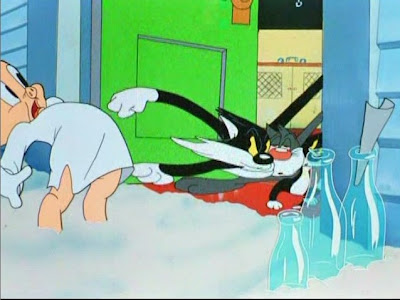
Fans frequently ask, "What happened to Clampett after he left Warner Bros?" Here's an article by Milt Gray that attempts to answer that. Be sure to click to enlarge.

At first glance, it's hard to imagine why Bob left Warners. In his last year there he directed an almost unbroken string of masterpieces, including: "Piggy Bank Robbery," "Book Review," and "Kitty Kornered." He had an ideal situation there, with Scribner and McKimson animating for him, Warren Foster writing, Mel Blanc doing voices, and the services of Carl Stalling and the Warner Brothers house orchestra...the same orchestra used by Steiner, Waxman and Korngold. So what happened? Why did he leave?

It's my belief that Jones and Freleng convinced the studio that Clampett's flamboyant approach to films was incompatible with the new, more sedate and formulaic studio style that these directors favored. Leon Schlesinger had recently left, and without a protector, Bob was left to face the wolves alone. This is pure and utter speculation on my part, without a shred of evidence, but it gels with my understanding of big studio politics.
I talked to Milt about this and he underscored what was in his article, namely that Bob left because he was hot to start his own cartoon studio the way Lantz and Disney had, and that he was anxious to get in on the ground floor of the new medium, television. Bob had witnessed the birth of radio which had a decade of extreme creativity before executives moved in and put a wet blanket on it, and we can guess that he thought TV would experience a similar creative spurt.

Actually TV had only a brief creative life at the start because it inherited an already existing executive infrastructure from radio. Poor Bob collided with these people early and was forced to make extensive changes in the animated Beany and Cecil at his own expense.
So who's right? Milt or me? Milt knows more about all this than I do, and had a much longer personal association with Bob. My own belief is that we're both right, but my version of the story rests on assumptions and I won't blame anyone who remains skeptical.

Two years after Bob left Warners he got an offer from Republic to take charge of their cartoon division, and make cartoons there. He was promised creative freedom but that never really materialized, and Republic...for reasons having nothing to do with Bob...decided to stop making theatrical cartoons. The closest thing to a finished cartoon in his own style was "Grand Old Nag (above)," which was so compromised and unClampett-like that he declined to use his real name in the direction credit. You can see this film on YouTube, and a version with commentary on Cartoon Brew.
Clampett's next endeavor was Beany and Cecil, and that's mostly what Milt writes about below. The article first appeared in Apatoons magazine.






That's it for the article, but there's more to say. The long awaited "Beany and Cecil Special Edition Volume 2" DVD should be in the stores on September 8th!

But why wait for the stores when you can buy Volume 2 right now from the Beany and Cecil web site? Actually, you can also get Volume 1 there. Rob Clampett says he found a limited supply of Volume 1 unopened in the family warehouse. He's offering to sell one per customer to anyone who buys a copy of Volume 2. Volume 2 sells for $24.95 + Shipping. Volumes 1 & 2 (purchased together) sell for $54.95 + Shipping. Wow! What a deal! Volume 1 is long out of print and gets high prices on ebay. Here's a chance to get it for 25 bucks!
Info on the contents can be had from the new Beany and Cecil web site: www.beanyandcecil.com



























































